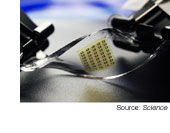|
NEWS
|
Better heat-to-electricity
A thermoelectric material gets a 40 percent performance
boost when formed from nanocrystals. Thermoelectric materials
convert heat to electricity or, when electricity is applied
to them, provide cooling without gases or mechanical parts.
Improved thermoelectric materials could be used to generate
power from waste heat in power plants and vehicles. (High-Thermoelectric
Performance of Nanostructured Bismuth Antimony Telluride
Bulk Alloys, Science, publish online March
20, 2008)
Flexible silicon
 Stretchable and bendable computer circuits made
from ordinarily brittle single-crystal silicon promise
flexible electronic devices that perform at nearly the
same level as today's rigid computer chips. Possible uses
include wearable health monitors. The work advances previous
research that allowed silicon to stretch in one dimension
(see "Silicon
gets stretchy"). (Stretchable
and Foldable Silicon Integrated Circuits, Science,
publish online March 27, 2008)
Stretchable and bendable computer circuits made
from ordinarily brittle single-crystal silicon promise
flexible electronic devices that perform at nearly the
same level as today's rigid computer chips. Possible uses
include wearable health monitors. The work advances previous
research that allowed silicon to stretch in one dimension
(see "Silicon
gets stretchy"). (Stretchable
and Foldable Silicon Integrated Circuits, Science,
publish online March 27, 2008)
Inkjet transistors
Upping the voltage through an inkjet printer head
shrinks the size of the ink droplets to one micron, or
a thousandth of a millimeter, which is small enough to
print lines two microns wide. Print a fluid containing
silver nanoparticles and the technique can be used to
make organic transistors on flexible plastic surfaces.
These printable transistors could lead to practical flexible
displays and electronic paper. (Organic
Transistors Manufactured Using Inkjet Technology with
Subfemtoliter Accuracy, Proceedings of the National
Academy of Sciences, publish online March 24, 2008)
Fetching robot
A robot that acts like a dog promises to help
the elderly and disabled. Point to an object with an off-the-shelf
green laser pointer, and the robot, whose camera is tuned
to green light, fetches the object. Then point to a spot
on the floor and the robot brings the object to that spot.
(A
Point-and-Click Interface for the Real World: Laser Designation
of Objects for Mobile Manipulation, 2008 ACM/IEEE
International Conference on Human-Robot Interaction (HRI
2008), March 12-15, 2008, Amsterdam, the Netherlands)
Single photons from space
Efforts to extend quantum communications to space
received a boost with an experiment that bounces weak
laser pulses off a satellite. The reflected pulses simulate
a single-photon light source on a satellite. Single-photon
sources are crucial to quantum communications, including
theoretically perfectly secure quantum cryptography. Quantum
communications via satellite could be used to send the
signals over long distances using satellite relays. (Experimental
Verification of the Feasibility of a Quantum Channel between
Space and Earth, arXiv e-print service, posted March
12, 2008)
Matter wave magic trick
In recent years scientists have produced matter
waves -- orderly streams of chilled atoms -- with an eye
toward making sensitive instruments. Put a lattice of
laser beams around an object and matter waves bend around
the object in the same way that recently devised invisibility
cloaks bend light waves around objects. This matter-wave-bending
technique can be used to steer and focus matter waves,
which could lead to matter wave instruments, including
highly precise gyroscopes. (Cloaking
of Matter Waves, Physical Review Letters, March
28, 2008) |
FEATURES
|
View
from the High Ground: ICL's John Pendry
Physics as machine tool, negative refractive
index, metamaterials, shattered wine glasses, higher capacity
DVDs, scientific backwaters, risk perception and practice,
practice, practice.
|
How
It Works: Quantum computing: qubits
Photons, electrons and atoms, oh my! These particles are
the raw materials for qubits, the basic building blocks
of quantum computers. |
|
 |
News RSS feed 
Blog RSS feed 
Bookshelf RSS feed

New: TRN's
Internet Services
TRN's Jobs Center
|
| |
|
| |
|
| |
"Physics
is to the rest of science what machine tools are
to engineering. A corollary is that science places
power in our hands which can be used for good or
ill. Technology has been abused in this way throughout
the ages from gunpowder to atomic bombs."
- John Pendry, Imperial College London |
|
| |
|
| |
Thanks
to Kevin from
GoldBamboo.com
for technical support |
|

